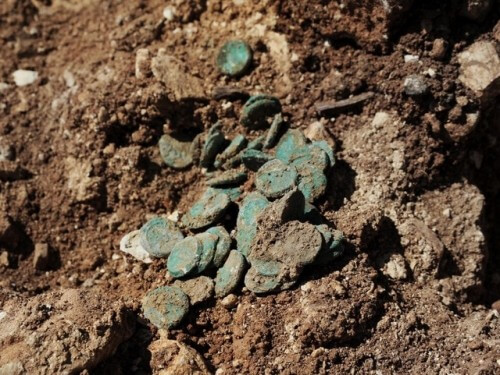The treasure, which was kept in an earthenware box, included 114 bronze coins, dating to the fourth year of the great revolt against the Romans. This rebellion led to the destruction of the house, on the 2000th of Av about XNUMX years ago.

Fragments of pottery discovered by the inspector of the Antiquities Authority during the extensive works of the Israel Routes Company in the new Highway 1 project a few months ago, led to an archaeological dig, during which an unknown settlement from the end of the Second Temple period was uncovered, and in one of its houses a rare treasure. The treasure, which was kept in an earthenware box, included 114 bronze coins, dating to the fourth year of the great revolt against the Romans. This rebellion led to the destruction of the house, on the 2000th of Av about XNUMX years ago.
More on the subject on the Hidan website in the series of articles by Dr. Yehiam Sorek:
- The great rebellion and the priesthood
- The great rebellion was almost averted at the last moment
- A total mess in Jerusalem
- The Great Revolt - How Big and How Necessary?
- Unusual concentrations of silver in pottery from the end of the Second Temple
According to Pablo Betzer and Eyal Marko, the managers of the excavation on behalf of the Antiquities Authority, "the treasure, which seems to have been deposited a few months before the destruction of Jerusalem, allows a glimpse of Jewish life in the suburbs of Jerusalem at the end of the rebellion. It seems that someone here sensed the end was near and hid his property here, perhaps hoping to collect it in quieter days." All the coins have a cup stamped on one side and around it the inscription "Lagalat Zion" and on the other side a model is depicted that includes a Lolev scroll between two etrogs. Around this model appears the inscription "Year Four", meaning the fourth year of the great revolt of the Jews against the Romans (year 69/70 AD).
The treasure was hidden in the corner of a room, possibly in a niche in the wall, or sunk into the floor. During the archaeological dig, two additional rooms and a courtyard belonging to the same building were uncovered. The structure was built in the 1st century BC, and it was destroyed in 69 or 70 AD, during the suppression of the Great Revolt. At the beginning of the 2nd century AD, part of the building was returned to use for a short period, which ended with the destruction of the Jewish settlement in Judea as a result of the Bar Kochba rebellion. Evidence of this is three whole jugs that were discovered submerged in the courtyard floor.
It seems that the residents of this village, like most of the Jewish villagers in Judea, took an active part in the two major revolts against the Romans - the Great Revolt and the Bar Kochba Revolt. As a result of this participation, the place was destroyed twice, and will not be rebuilt.
The Antiquities Authority and Israel Routes Company are examining the possibility of preserving the remains of the village as part of the development of the landscape along the road.
